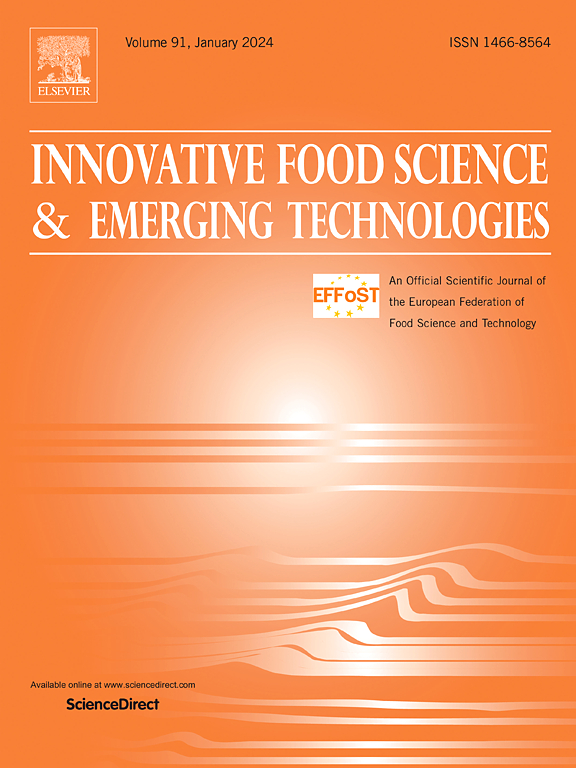Design and evaluation of a resonant sono-plate combined with infrared radiation to accelerate food drying at near-freezing temperatures
IF 6.3
1区 农林科学
Q1 FOOD SCIENCE & TECHNOLOGY
Innovative Food Science & Emerging Technologies
Pub Date : 2025-06-03
DOI:10.1016/j.ifset.2025.104068
引用次数: 0
Abstract
This study designed and developed an ultrasonically vibrating sono-plate operated in conjunction with infrared radiation to accelerate the drying of solid foods at near-freezing temperatures. The prototype utilized resonance to generate ultrasonic standing waves to transmit acoustic energy from an aluminium plate to the food sample. The injected ultrasonic energy accelerates drying while maintaining near-freezing temperatures (−5 to 5 °C) to better preserve food quality. The prototype was designed by modelling the transmission of sound through the system. The efficacy of the system was evaluated through drying apple slices with different ultrasound (US) power levels (0, 50, 100 W), infrared radiation (IR) power (0, 100, 200 W), and drying temperatures (−5, 0, 5 °C) with nitrogen as the drying medium to reduce oxidative degradation. The application of US and IR reduced the drying time relative to the control by 31.6 % and 47.5 %, respectively. The combined application of US and IR resulted in a 54.7 % reduction in drying time. Moreover, the effect on the physico-chemical properties of dried apples was evaluated. Near-freezing temperature treatments with US, IR, and their combination did not significantly affect (p < 0.05) colour, shrinkage, antioxidant activity (AA), total polyphenol content (TPC), and textural properties of rehydrated slices relative to the control. Near-freezing US-IR drying was compared to hot air drying (40 °C) (HAD) and vacuum freeze drying (VFD). The colour of US and IR-assisted dried apple slices was preserved better than HAD and VFD. The study demonstrated that near-freezing drying can be accelerated with the assistance of US and IR without affecting quality relative to the control.
Industrial relevance of the research
Industries seek drying technologies that reduce temperature damage to dried foods while reducing drying times. In this study, US combined with IR reduced drying time by half (54.7 %) while preserving the quality attributes of dried apples due to the near-freezing temperatures. There were no significant (p < 0.05) differences in the measured quality attributes compared to drying without US and IR at the same temperature. Hence, this technology offers a viable industrial alternative to accelerate drying at low temperatures. Furthermore, the designed ultrasonic system achieved a high electrical efficiency of 93.5 %. This indicates that most of the electrical power used in the US was converted into ultrasonic vibrations. The better rehydration behaviour achieved at near-freezing temperatures can be applied to instant and ready-to-eat food formulations, targeting premium dried products, functional foods, and high-value ingredients.
结合红外辐射的共振声纳板在接近冰点温度下加速食品干燥的设计与评价
本研究设计并开发了一种结合红外辐射的超声振动声纳板,以加速固体食品在接近冰点温度下的干燥。该原型利用共振产生超声波驻波,将声能从铝板传递到食品样品。注入的超声波能量加速干燥,同时保持接近冰点的温度(- 5至5°C),以更好地保存食品质量。原型是通过模拟声音在系统中的传输来设计的。通过不同的超声(US)功率(0、50、100 W)、红外(IR)功率(0、100、200 W)和干燥温度(- 5、0、5℃),以氮为干燥介质,对该系统的效果进行评价,以减少氧化降解。与对照相比,US和IR的使用使干燥时间分别缩短了31.6%和47.5%。美国和红外线的联合应用导致干燥时间减少54.7%。并对其对苹果干理化性质的影响进行了评价。近冰点温度处理与US、IR及其组合对(p <;0.05)的颜色,收缩率,抗氧化活性(AA),总多酚含量(TPC),和织构性能相对于对照。近冷冻US-IR干燥与热风干燥(40°C) (HAD)和真空冷冻干燥(VFD)进行了比较。US和ir辅助下的苹果干片的颜色保存效果优于HAD和VFD。研究表明,在美国和红外线的帮助下,近冷冻干燥可以加速,而不影响相对于对照的质量。研究的工业相关性行业寻求干燥技术,减少干燥食品的温度损害,同时减少干燥时间。在这项研究中,由于接近冰点的温度,US与IR结合将干燥时间缩短了一半(54.7%),同时保留了干苹果的质量属性。无显著差异(p <;0.05)与在相同温度下无US和IR干燥相比,所测质量属性的差异。因此,这项技术提供了一个可行的工业替代方案,以加速在低温下干燥。此外,所设计的超声波系统达到了93.5%的高电效率。这表明在美国使用的大部分电力被转换成超声波振动。在接近冰点的温度下获得的更好的再水化行为可以应用于速食和即食食品配方,目标是优质干货,功能食品和高价值成分。
本文章由计算机程序翻译,如有差异,请以英文原文为准。
求助全文
约1分钟内获得全文
求助全文
来源期刊
CiteScore
12.00
自引率
6.10%
发文量
259
审稿时长
25 days
期刊介绍:
Innovative Food Science and Emerging Technologies (IFSET) aims to provide the highest quality original contributions and few, mainly upon invitation, reviews on and highly innovative developments in food science and emerging food process technologies. The significance of the results either for the science community or for industrial R&D groups must be specified. Papers submitted must be of highest scientific quality and only those advancing current scientific knowledge and understanding or with technical relevance will be considered.

 求助内容:
求助内容: 应助结果提醒方式:
应助结果提醒方式:


